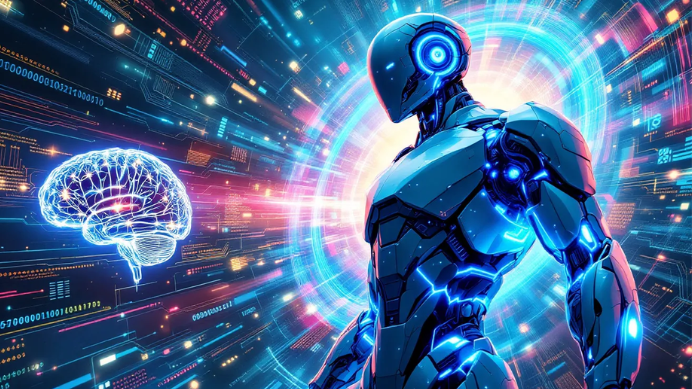
Agentic AI vs Generative AI: What’s the Buzz About?
In the world of AI, understanding the differences between Agentic AI vs. Generative AI is crucial. Agentic AI makes decisions and executes tasks autonomously, while Generative AI focuses on creating new content from data patterns.
Understanding these two AI systems is essential for businesses and individuals looking to harness the power of artificial intelligence effectively. By exploring the unique capabilities and applications of both Agentic AI and Generative AI, you can make informed decisions on integrating these technologies into your operations, ultimately driving innovation and achieving your organizational goals.
What is Agentic AI?
Agentic AI refers to a category of AI systems that possess the ability to act autonomously and make independent decisions.
This type of AI is designed to learn and adapt to various situations in order to achieve specific goals without requiring direct human intervention. Essentially, it functions like a virtual assistant that can think, reason, and respond to changing circumstances on its own.
The concept of agentic AI encompasses systems that utilize sophisticated reasoning and iterative planning to tackle complex, multi-step problems. These systems are often referred to as AI agents, which highlights their capability to operate independently.
Characteristics of Agentic AI
Agentic AI systems exhibit several defining characteristics that set them apart from traditional AI models. Here are the key characteristics:
- Autonomy: One of the most significant traits of agentic AI is its ability to operate independently. These systems can make decisions and take actions without requiring constant human oversight, allowing them to function effectively in dynamic environments.
- Real-time adaptation: Agentic AI can adapt its strategies and approaches in real time based on the context and objectives it encounters. This flexibility enables the system to respond to changing conditions and requirements swiftly.
- Complex problem solving: These AI systems are designed to tackle multi-step problems, leveraging advanced reasoning capabilities. They can analyze vast amounts of data, identify patterns, and generate insights that guide their actions toward achieving specific goals.
- Self-optimization: Agentic AI continuously improves its performance through a feedback loop, where data generated from its interactions is used to refine its models. This self-optimizing capability enhances the effectiveness of the AI over time.
- Integration of multiple AI agents: Agentic AI often consists of multiple AI agents that work together, utilizing large language models (LLMs) and complex algorithms to mimic human decision-making processes. This collaborative approach allows for more sophisticated and nuanced responses.
- Goal-oriented behavior: These systems are specifically designed to pursue defined objectives, making them highly effective in automating complex workflows and enhancing operational efficiency.
Examples of Agentic AI
Agentic AI is being integrated into various sectors, showcasing its potential to enhance efficiency and automate complex tasks. Here are some notable examples:
- Autonomous vehicles: One of the most prominent examples of agentic AI is in autonomous vehicles. These vehicles utilize AI to make real-time decisions regarding navigation, route optimization, and obstacle avoidance. By employing predictive algorithms, they can respond to changing road conditions faster than human drivers, significantly improving safety and efficiency.
- AI in business intelligence: Agentic AI can be paired with business intelligence (BI) solutions to provide actionable insights. For instance, an AI agent can analyze data and advise marketing teams on budget allocation or even create visual representations of data based on simple sketches, enhancing decision-making processes.
- Content creation and editing: AI agents are also being used in content creation, where they can autonomously generate, edit, and publish written material. These systems can assist human writers by personalizing content to suit specific audiences, thereby streamlining the content production process.
- Customer support automation: In customer service, agentic AI is transforming call centers by orchestrating various activities involved in serving customers. These AI agents can handle inquiries, resolve issues, and provide information, significantly improving response times and customer satisfaction.
- Healthcare systems: Advanced healthcare systems are leveraging agentic AI to automate administrative tasks, manage patient data, and assist in diagnostics. This not only reduces the workload on healthcare professionals but also enhances the accuracy and speed of patient care.
- Testing automation: In software development, agentic AI can perform complex testing tasks under human oversight. For example, AI agents can design, execute, and analyze tests for applications, creating recurring reports that help teams monitor ongoing projects effectively.
What is Generative AI?
Generative AI refers to a subset of artificial intelligence that utilizes deep learning models to create new content, such as text, images, videos, and music, based on the data it has been trained on.
This technology is capable of learning from various forms of input, including human language and complex datasets, allowing it to generate high-quality outputs that can mimic or innovate upon existing styles and formats.
Generative AI operates by identifying patterns and structures within its training data, which it then uses to produce novel content. For instance, it can take a written description and transform it into an animated video or a piece of music.
What are the key characteristics of Generative AI?
The characteristics of Generative AI include the following:
- Content creation: Generative AI is designed to create new content, such as text, images, videos, and music, based on the patterns it learns from existing data. This ability allows it to produce original artifacts that reflect the characteristics of the training data without simply replicating it.
- Learning from data: These models utilize neural networks to identify and understand the underlying patterns and structures within their training datasets. This process enables them to generate outputs that are coherent and contextually relevant.
- Flexibility in learning approaches: Generative AI can leverage various learning methods, including unsupervised and semi-supervised learning. This flexibility allows it to adapt to different types of data and tasks, enhancing its capability to generate diverse content.
- Accelerated ideation: By automating the content generation process, generative AI accelerates ideation and creativity. It allows users to visualize and bring their ideas to life more efficiently, freeing up time for more creative pursuits.
- Mapping data relationships: Generative AI encodes existing information into a vector space, mapping data points based on their correlations. This mapping helps the model understand dependencies within the data, which is crucial for generating relevant outputs.
Examples of Generative AI
Generative AI has a wide range of applications across various fields, showcasing its versatility and innovative capabilities. Here are some notable examples:
- Text generation: Tools like ChatGPT are designed to generate human-like text based on prompts. They can be used for various purposes, including writing articles, creating conversational agents, and generating marketing content. These models can summarize information, answer questions, and even engage in dialogue with users.
- Music composition: Generative AI can also compose music by analyzing existing songs and learning patterns in melody, harmony, and rhythm. Tools like OpenAI’s MuseNet can generate original compositions in various styles, from classical to contemporary genres.
- Code generation: AI models like OpenAI Codex and GitHub Copilot assist developers by generating code snippets based on natural language descriptions. This helps streamline the coding process and helps programmers by providing suggestions and automating repetitive tasks.
- Video generation: Generative AI is being used to create videos by synthesizing new footage or altering existing clips. This technology can be applied in entertainment, advertising, and educational content, enabling the production of engaging visual narratives.
- Game development: In the gaming industry, generative AI can create dynamic environments, characters, and storylines, enhancing the gaming experience. This allows for more immersive and personalized gameplay, as the AI can adapt to player choices and actions.
- Fashion design: Generative AI is also making waves in fashion by designing clothing and accessories based on trends and consumer preferences. AI can analyze vast amounts of data to predict styles that will resonate with audiences, leading to innovative fashion collections.
Generative AI vs Agentic AI: Key Differences
| Aspect | Generative AI | Agentic AI |
| Definition | Creates new content like text, images, music, or videos based on learned patterns. | Performs goal-driven tasks, makes decisions, and acts autonomously in dynamic environments. |
| Primary Purpose | Generates creative outputs for artistic or communicative purposes. | Executes tasks, makes decisions, and achieves specific objectives without constant human input. |
| Core Functionality | Uses large datasets to learn patterns and create new content. | Analyzes environments, makes decisions, and adapts actions to meet goals. |
| Technologies Used | Relies on Generative Adversarial Networks (GANs) and Transformer Models (e.g., GPT, BERT). | Utilizes reinforcement learning, decision trees, robotics frameworks, and sensor fusion. |
| Output Type | Produces creative content such as articles, music, images. | Delivers functional outputs like navigation decisions, task executions, or problem-solving actions. |
| Interaction Style | Collaborative; works based on user prompts and input. | Autonomous; acts independently once set up. |
| Strengths | Excellent for creativity, content automation, and enhancing human innovation. | Known for efficiency, autonomy, and scalability in complex environments. |
| Limitations | Can produce biased or nonsensical outputs based on training data. | Complex to implement; requires ethical considerations and safeguards. |
| Applications | Content creation, design, media assets, code generation. | Robotics, advanced customer support, data analysis, autonomous operations, task automation. |
| Learning Process | Typically uses supervised learning for pattern recognition. | Often employs reinforcement learning for goal-oriented behavior. |
| Feedback Mechanism | Feedback is often manual, based on human evaluation of generated content. | Feedback can be automated through reward functions or sensor data. |
| Autonomy Level | Limited autonomy; requires user input for operation. | High autonomy; can operate independently with minimal human intervention. |
| Adaptability | Adapts to new data or prompts but within predefined parameters. | Can adapt to changing environments and unexpected situations. |
| Error Handling | Errors are often identified through human review. | Errors can be detected and corrected autonomously using feedback loops. |
| Ethical Considerations | It concerns bias, misinformation, and intellectual property. | It concerns safety, privacy, accountability, and decision-making transparency. |
| Development Complexity | Relatively straightforward to develop with large datasets. | More complex to develop due to the need for sophisticated decision-making algorithms. |
| Real-World Impact | Enhances productivity in creative fields and automates repetitive tasks. | Can transform industries by automating complex processes and improving efficiency. |
Generative AI and Agentic AI represent two branches of artificial intelligence, each with unique capabilities and applications. Generative AI specializes in creating new content such as text, images, music, and videos by analyzing patterns from large datasets. It is reactive, requiring user prompts to generate outputs, making it ideal for creative tasks like content generation and design.
In contrast, Agentic AI is action-oriented, designed to make autonomous decisions, adapt to dynamic environments, and execute multi-step tasks with minimal human oversight. It operates proactively, enabling applications like autonomous vehicles, virtual assistants, and workflow automation.
While Generative AI excels in creativity and pattern recognition, Agentic AI focuses on autonomy and goal-driven behavior, making it better suited for decision-making and task execution in real-world scenarios. Together, these two forms of AI complement each other by blending creativity with autonomy to address diverse challenges across industries.
AI automation companies leverage these two AI-powered solutions to offer personalized tech services to B2B clients. Connect with iTCart – a AI automation company that solves all your requirements at ease.






